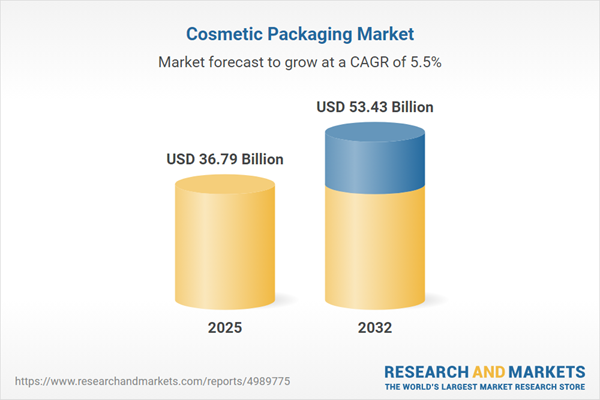Speak directly to the analyst to clarify any post sales queries you may have.
The cosmetic packaging market is rapidly evolving as sustainability, regulatory pressures, and digital innovation reshape industry expectations and competitive strategies. This report delivers targeted insights for senior decision-makers seeking to adapt to changing market dynamics and capitalize on new opportunities in cosmetic packaging.
Cosmetic Packaging Market Snapshot
The cosmetic packaging market grew from USD 34.92 billion in 2024 to USD 36.79 billion in 2025 and is projected to reach USD 53.43 billion by 2032, exhibiting a CAGR of 5.45%. The rising demand is shaped by consumer calls for visual appeal and sustainability, growing regulatory oversight, and ongoing advances in materials and packaging technologies. Market players face an increasingly complex environment, with global supply considerations, cost control, and rapid response to consumer trends at the forefront.
Scope & Segmentation
- Product Types: Color cosmetics—foundation, lipsticks, mascara; fragrances—cologne, perfume; haircare—conditioners, hair oils, shampoos; skincare—body lotions, eye creams, face creams.
- Material Types: Glass—including amber and flint; metal—aluminum, tinplate; paperboard—folding cartons, paper bags; plastic—PET, polyethylene, polypropylene.
- Distribution Channels: Offline—department stores, drug stores, specialty stores, supermarkets and hypermarkets; online—brand websites and e-commerce platforms.
- Packaging Types: Primary—bottles, jars, pumps, tubes; secondary—boxes, sleeves.
- End Use: Professional—salon products, spa products; retail—standard; travel—miniatures, travel kits.
- Regions: Americas—including United States, Canada, Mexico, Brazil, Argentina, Chile, Colombia, Peru; Europe, Middle East & Africa—including United Kingdom, Germany, France, Russia, Italy, Spain, Netherlands, Sweden, Poland, Switzerland, United Arab Emirates, Saudi Arabia, Qatar, Turkey, Israel, South Africa, Nigeria, Egypt, Kenya; Asia-Pacific—including China, India, Japan, Australia, South Korea, Indonesia, Thailand, Malaysia, Singapore, Taiwan.
- Key Companies: Amcor plc, AptarGroup, Inc., Berry Global Group, Inc., WestRock Company, Silgan Holdings Inc., Albéa S.A., CCL Industries Inc., Gerresheimer AG, Quadpack Industries SLU, Graham Packaging Company.
Key Takeaways
- Consumer preferences are shifting toward clean beauty, transparency, and eco-conscious product presentation, making packaging a core brand differentiator.
- Regulatory changes require enhanced material traceability and prompt brands to reassess material sourcing and legacy packaging structures.
- Technology is accelerating, with digital printing, QR integration, and augmented reality experiences unlocking new opportunities for personalization and consumer engagement.
- Sustainable design principles—such as refillable systems and mono-material packaging—are gaining ground, aligning business practices with circular economy goals.
- Strategic partnerships between material scientists, designers, and converters are driving advances in bioplastics and lightweight packaging innovations.
- Distributors and e-commerce channels shape packaging durability and unboxing experiences, making supply chain adaptability a competitive necessity.
Tariff Impact on Cosmetic Packaging
Recent US tariff adjustments have introduced cost pressures on imported glass and metal packaging inputs. This has prompted brands to explore domestic material sources, shift to recycled aluminum and flint glass, and innovate with composite materials. Supply chain strategies now increasingly prioritize diversified suppliers and modular designs to contain costs and maintain brand presentation standards. Retailers and online platforms are revising promotion and stock allocation tactics to reflect new cost structures, while tiered pricing models help manage downstream impacts.
Methodology & Data Sources
This research employs in-depth interviews with packaging manufacturers, beauty brands, and suppliers, paired with industry surveys and shipment databases. Secondary sources include trade association data, patent filings, environmental policy documents, and academic journals. Data triangulation ensures consistency and reliability across insights relating to market drivers, segmentation trends, and supply chain dynamics.
Why This Report Matters
- Equips executive leaders with actionable strategies to address evolving sustainability standards and competitive threats in cosmetic packaging.
- Delivers clear analysis of regulatory, technological, and trade forces influencing sourcing, design, and go-to-market tactics for packaging leaders.
- Enables supply chain, innovation, and marketing teams to benchmark best practices and anticipate category disruptions for proactive planning.
Conclusion
Senior decision-makers can leverage this report to guide strategic investments and innovation initiatives in the dynamic cosmetic packaging sector. The findings set the stage for adaptive, resilient growth amid changing consumer, regulatory, and global trade environments.
Additional Product Information:
- Purchase of this report includes 1 year online access with quarterly updates.
- This report can be updated on request. Please contact our Customer Experience team using the Ask a Question widget on our website.
Table of Contents
3. Executive Summary
4. Market Overview
7. Cumulative Impact of Artificial Intelligence 2025
Companies Mentioned
The companies profiled in this Cosmetic Packaging market report include:- Amcor plc
- AptarGroup, Inc.
- Berry Global Group, Inc.
- WestRock Company
- Silgan Holdings Inc.
- Albéa S.A.
- CCL Industries Inc.
- Gerresheimer AG
- Quadpack Industries SLU
- Graham Packaging Company
Table Information
| Report Attribute | Details |
|---|---|
| No. of Pages | 188 |
| Published | November 2025 |
| Forecast Period | 2025 - 2032 |
| Estimated Market Value ( USD | $ 36.79 Billion |
| Forecasted Market Value ( USD | $ 53.43 Billion |
| Compound Annual Growth Rate | 5.4% |
| Regions Covered | Global |
| No. of Companies Mentioned | 11 |









